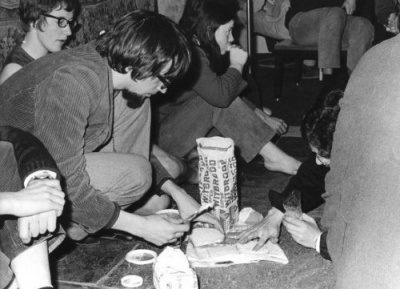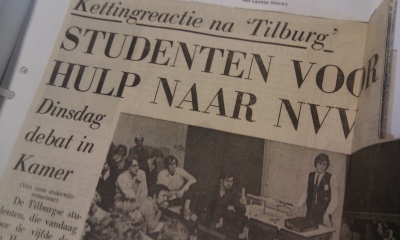Occupation
Tilburg University was occupied several times, but the most sensational occupation was the one in 1969, when the then Catholic College of Tilburg was occupied from 28 April till 7 May by students demanding changes in the University’s management and its education. The Tilburg occupation was the first in the Netherlands, to be followed by the Maagdenhuis occupation in Amsterdam several weeks later.
Karl Marx
There had been rumbles in Tilburg for some time before that. In February 1969, the words Karl Marx University had been painted in red on the facade of the Cobbenhagen Building. When the Board had drafted a memorandum in which participation rights played no role of any significance whatsoever, there had been sit-ins with students demanding participation rights. And then there was the so-called “Memo 21,” drafted by students, staff and some professors, proposing a management structure with “participation rights for all echelons at all levels.”
The conflict that arose over these memorandums caused a small group of students to reinforce their demands by occupying the telephone exchange, which, incidentally, was a mere piece of cake. This occupation, tiny though it was, then led president-curator Paul van Boven to close down the College, which, in its turn, caused the Rector Cees Scheffer to suspend all lectures and exams. This then in effect meant that a strike was imposed from the top down on all faculty against all students.
Hectic meetings
Students ‒ both left and right ‒ and many members of staff opposed this decision as well as the Curatorium itself. What followed was a hectic meeting in the Auditorium, with 1,500 present, and a series of sit-ins and teach-ins. To prevent the College from closing down in actual fact, the students decided to remain in the building. And so, in spite of all its calm, collected and Catholic decorum, Tilburg was having a veritable occupation on its hands. The occupation caused a flurry of media exposure and negotiation fever. After a week of negotiations, the Curatorium and the Senate came up with a proposal, voiced by pro-Rector Jan van Dijck: “In principle, the Senate recognizes participation rights for all echelons at all levels as a starting-point for deliberations on the structure of the College.”
Other universities
Student campaigns like this one were not restricted to Tilburg. In Amsterdam, Nijmegen and Groningen, students were also demanding participation rights and reforms in higher education in the Netherlands. The Cabinet met to discuss the Tilburg emergency on 2 May 1969. With disturbances also having taken place in Amsterdam on 30 April and 1 May, the phrase that was used was “a proliferating crisis of authority.” It was assumed that things in Amsterdam were under control but that the Tilburg students “had gained the upper hand.” On 6 May, Minister for Education Veringa felt obliged to make a statement in the House of Representatives, condemning both the occupation and the closure; he was aware of the upsides of the student riots but he also accepted the autonomy of the College Board; then he proceeded to describe the affaire as a “crisis of confidence” and called for de-escalation, for bringing parties together and for exploring avenues of communication.
The student protests gave rise to Veringa’s University Governance Reform Act (WUB) from 1971. The Curatorium and the Senate made way for a Board, controlled by a College Council (later University Council). Each faculty, in addition, acquired its own board, controlled by a faculty council. Students were admitted to these councils and thus gained the participation rights they had wanted. In the nineties, when the University Governance Modernization Act (MUB) was introduced, their powers were once more significantly limited.
More occupations
After the occupation of 1969, the College witnessed a few other shorter occupations. In 1978, when POLEK students were backing the introduction of the subject of “Political Economy and the Social Order (PEMO)” on the curriculum, they occupied the current Cobbenhagen Building. In 1979, there was a brief occupation of Building B (now Koopmans Building) because of the austerity plans of the then Faculty of Social Sciences (now Social and Behavioral Studies). Even the Sports Center was once occupied for a brief while in 1984 by angry students who opposed plans for granting permission to higher


